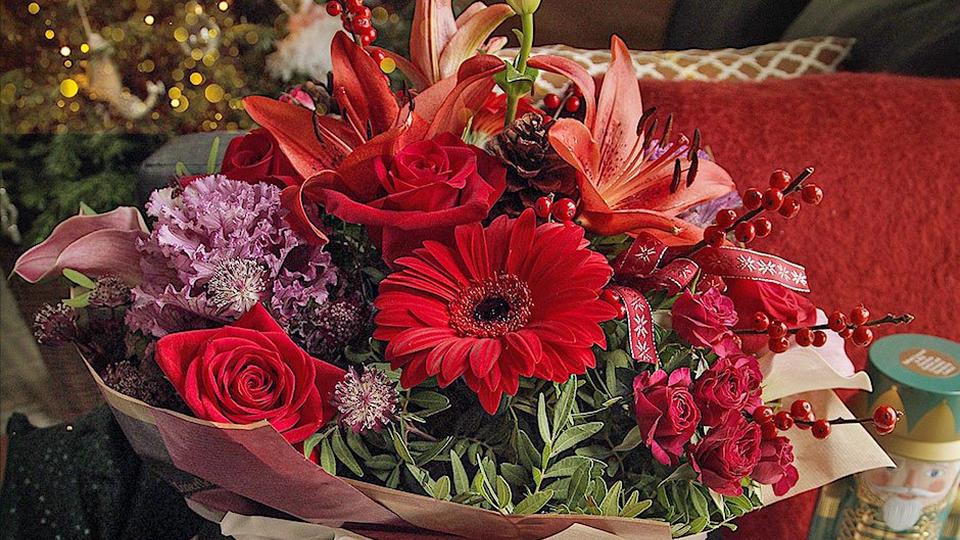How to Make a Christmas Garland

Step by step guide to making a Christmas garland
Instructions
Cut your rope to the length you want
The rope is your base (it’s less harmful to the environment than floral foam). We made our garland for a mantlepiece, but you could do one for the Christmas table.
Prep your foliage
Cut you spruce, eucalyptus, hypericum, skimmia and conifer into pieces (range them from around 10 – 20cm) and make a few piles ready to use. It should be starting to smell like Christmas!
Start wrapping!
Yes more Christmas wrapping, but a different kind. Take your florist’s wire and wrap it around the left-hand side end of the rope a few times. You’re steadily going to wrap the wire all the way along the rope, tucking the foliage in as you go with the facing right. To get started take a piece of spruce, and some conifer, place them on top of you rope and wire, then wrap the wire around both to secure them.
Keep wrapping!
Keep adding foliage, and occasionally your berries and asparagus fern, and winding the wire round to secure them. You might want to keep trimming the stems if they’re very long.
TOP TIP: Try and keep it nice and flat so it’ll lie flat against the surface you put it on.
Finish by securing the wire
Once your nearly at the end of your rope, grab a piece of spruce and a piece of conifer, point them the other way to the rest of the garland and wire round them to secure them. This will hide the end of the rope. Then flip the whole end of the garland over and pull your wire nice and tight. Leave a length of wire (around 15cm) and then cut it. Twist this round the rope to secure it, and trim any excess rope.
6. Add any finishing touches, like oranges
If you want you could stop here, because we’re sure the garland is already looking gorgeous. But if you wanted to finish it off – there’s a few bits you can add to make it look extra lovely. We’ve picked dried orange and pinecones. To attach an orange slice, take 15cm of wire and push it through the flesh just below the skin of the orange, pull the two bits of wire together and do a few twists, then pull the wire straight. To attach it to the garland push it through the foliage near the rope, then flip the garland over and find the end of the wire. Bend it back towards the orange, tucking it around the rope. Repeat for your other orange pieces and spread them along your garland.
7. Add pinecones
To attach the wire to a pinecone, grab one and have the pointy end facing towards you. Take a 15cm piece of wire and thread it through the cone, so you have equal amounts either side. Pull one of the sides around the bottom of the cone, nice and tight, so it joins the other piece of wire. Entire the wire, then straight it out – now it’s ready to attach to the garland the same way you did your orange slices.
8. Display it for all to admire.
Voila, your gorgeous garland is done! All you need to do is gently move it to where it’ll be on show and soak up the joy of making something so lovely (and low impact on the planet).
Making a sustainable Christmas garland
‘Sustainable’ is a funny phrase – what does it really mean? Well, here we’re using it to mean a garland that doesn’t use irreplaceable natural resources, cause environmental harm or upset the balance of our planet’s ecosystems. We want garlands that are green in every sense! There are a few ways to make sure your homemade garland is sustainable, and a few things to watch out for.
-
Don’t use floral foam (this is usually fossil fuel based).
-
Use plants and foliage grown locally (or in the UK) and/or organically (this reduces their carbon footprint through travel or through growing them in an intensive way).
-
Compost your garland after the festivities are over.
-
Reuse your floral wire year after year.
While it’s tempting to use a plastic garland because it won’t wilt, the manufacture of it will use fossil fuels, and it could take up to 500 years to break down (often into harmful materials that cause pollution and harm to the environment). Opting for a fresh garland avoids this, and it should still be long-lasting – the foliage we picked for ours should last at least two weeks, if not longer.



